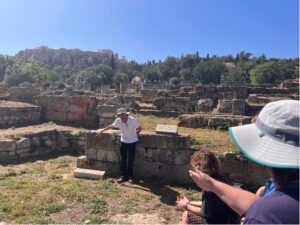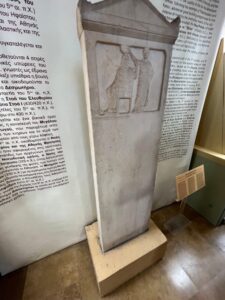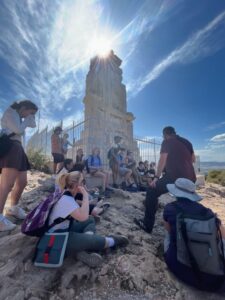Day 2: Agora, Kerameikos, Pnyx and Philappappos! by AJ Hartwick and Nolan Felker
We started our day at the Athenian Agora, where we were given a special tour by John Pappadopoulous, the Director of the Agora Excavations. Professor Pappadopoulous shared his incredible breadth of knowledge on the site, and also told us about personal stories relating to some of his archaeological discoveries. 
The Agora functioned as a marketplace and cultural hub of Ancient Athens. Some of the sites on the Agora included the Temple of Hephaestus, The Altar of the Twelve Gods, the Eponymous Heroes, and the supposed death place of Socrates. We also had the opportunity to visit the site museum, which houses artifacts that bring to life what Athenians used in their homes and elsewhere.
Nolan: My favorite artifact was the “Anti-Tyranny Stone”. It was an inscribed stele with a relief, and it had a very carefully worded Athenian law banning tyranny from the Athenian state, and giving the citizens the legal right to overthrow and murder any would-be tyrants. The Athenians took their democratic structure very seriously and the citizens could even democratically elect to ostracize an Athenian citizen of their choice if they were getting too power-hungry.
AJ: My favorite artifact was the Altar of the Twelve Gods, which functioned as a site of sanctuary and supplication in ancient Athens. Unfortunately, a train track runs through the Altar, and only a small corner is preserved today. Hearing about the planning process that went into preserving this small piece added layers to my understanding of the artifact, and also helped our class learn more about the logistics of maintaining an archaeological site.

After our adventures at the Agora, we were dismissed for an hour to eat lunch and explore the surrounding area. Then, we moved on to the next site of the day: the Kerameikos. The expansive archaeological site stretches along the city walls — including the Dipylon Gate — and also includes a vast array of funerary sculptures spanning hundreds of years. We also had the chance to visit the Kerameikos Museum, where we spent our time sketching an artifact that spoke to us personally.
AJ: I chose to sketch Head of a Figurine of a Female Mourner. This piece is dated around 580 BC, which places it in the Archaic Period. I was interested in the piece because it represented a votive mourner. The practice of offering the dead physical objects has always intrigued me. In particular, I find it fascinating that the Greeks offered symbols of an individual’s mourning that mirrored the mourner. Furthermore, I was struck by how solemn the figure seemed, which is a departure from how women were typically depicted in funerary art.
Nolan: My sketch was about a hydria, a specific form of pottery from the Archaic Era of Greece – this one from about 525 BCE – and it depicted a four-horse chariot with a Hoplite (soldier) astride. This pottery spoke to me because it held such a ferocious and warlike attitude for such a mundane item. Hydrias are designed to carry water, oil, wine, and on occasion votes or ashes of the dead, but this one is decorated like one was going to war. One can only wonder who is the hero astride the chariot and what war he rides for.
 The last stop of today was the Pnyx Hill and the Philopappou monument, on top of another hill just west, overlooking the Akropolis. After a long walk up we got to bask in the incredible views and the cool wind and take a look at one of the world’s largest and most audacious mausoleums to Gaius Julius Antiochus Epiphanes Philopappos. The monument reflects the wealth and power of its subject, who interestingly hailed from Syrian ancestry. The situation of the monument on the Mouseion Hill facing the Akropolis can be interpreted as an effort to associate Philopappou with the ancient strength and identity of Athens.
The last stop of today was the Pnyx Hill and the Philopappou monument, on top of another hill just west, overlooking the Akropolis. After a long walk up we got to bask in the incredible views and the cool wind and take a look at one of the world’s largest and most audacious mausoleums to Gaius Julius Antiochus Epiphanes Philopappos. The monument reflects the wealth and power of its subject, who interestingly hailed from Syrian ancestry. The situation of the monument on the Mouseion Hill facing the Akropolis can be interpreted as an effort to associate Philopappou with the ancient strength and identity of Athens.
And while AJ got some delicious Gyros, I went and visited the Ancient Roman Agora so who’s the real winner here? Overall, we had a packed day and we’re thrilled to have seen so many amazing sites!
Day 3: ?????
